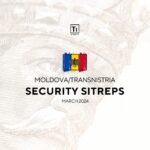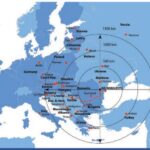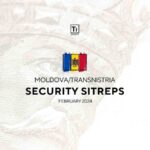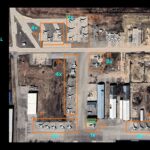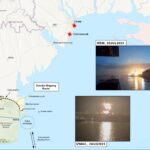(1) The White House and the U.S. Department of Defense are closely monitoring the situation in the greater Idlib region. Over the past days, the Bashar al-Assad regime has continued to amass army formations and Iranian-backed militias in the main assault positions around the opposition-held stronghold.
(2) The 4th Armored Division has been moved to Northern Hama. Their position is strengthened by a rare deployment of the Republican Guards, both near Lataminah and Jabal al-Turkmen. In Western Aleppo, Iranian-backed militias, spearheaded by Hezbollah and Iraqi Popular Mobilization Units (PMUs), are completing their transfer from the Deir ez-Zor frontline. The strategic Abu ad-Duhur airfield, located on Idlib’s Eastern flank, has been reinforced by the deployment of Assad’s most battle-hardened and elite unit, the Tiger Forces. Reconciled opposition groups from Da’ara province are also moving towards Idlib. The infantry build-up is supported by the Syrian Arab Air Force (SyAF), which has dispatched Mi-8/17 helicopters to Hama airfield, and by an unprecedented Russian naval deployment in the Eastern Mediterranean. Two days ago, the Syrian army closed al-Duhr checkpoint, the last civilian crossing out of Idlib.

Military Situation in the “Greater Idlib” region (August 2018)
(3) As the start of the offensive seems imminent, the U.S., France and the United Kingdom have voiced concerns that the Assad regime will follow the “Eastern Ghouta model” and launch chemical weapons (CW) attacks on opposition-held towns. Opposition groups claim that they have (unverified) information pointing towards the town of Kafr Zabl as the main target for the regime’s impending CW attack.
(4) The U.S. military and intelligence community are therefore on high alert for any signs that the Assad regime is readying chemical weapons for use in Idlib. The U.S. Central Command (CENTCOM) has stated that its assets are prepared, should President Trump order a strike. The American-British-French coalition has issued several warnings for Assad: Fight fair or expect another retaliation.
(5) At the moment, Assad’s preferred solution still seems to be a Russian-brokered reconciliation deal with the opposition in Idlib, similar to the deals negotiated in Eastern Ghouta, Da’ara and Rastan. Since early-August, Russia has been conducting talks with leaders of the non-al Qa’ida (AQ) opposition (the Turkish-backed “National Front for Liberation”) at the Reconciliation Center on Hmeimim air base (Latakia). Turkey has been encouraging opposition groups to join the talks and is reportedly coordinating with Russia on a settlement. Currently, Russia and Turkey are trying to convince the opposition groups to hand over all weapons heavier than 23mm anti-aircraft twin-barrel autocannons to the Turkish Army.
(6) However, the Russian and Turkish negotiation efforts have failed to produce meaningful results. The non-AQ opposition groups continue to strengthen their unified front and enhance frontline positions. The AQ camp in Idlib – Hay’at Tahrir al-Sham (HTS), Turkistani Islamic Party (TIP) and Tanzim Hourras al-Din – has slammed the idea of negotiations and is attacking any opposition group that has engaged in reconciliation talks with the government. Furthermore, the AQ-affiliated groups have refused Turkey’s proposal to join the “National Liberation Front.”
(7) The unsuccessful negotiations put the Assad regime in an increasingly difficult spot. According to intelligence estimates, a conventional military campaign to recapture Idlib would be devastating for the Syrian military with regard to resources, manpower, and capabilities. As Turkish troops are embedded in the Idlib frontline and equipped with man-portable air defense systems (MANPADS), air support for the advancing troops would be extremely limited.
(8) Should the reconciliation talks fail, a CW attack – as feared by the American-British-French coalition – is therefore becoming more likely. As the Eastern Ghouta and Khan Shaykhun precedents have shown, the Assad regime is willing to use CW attacks to coerce opposition groups into surrendering. Although the CW-option would likely trigger new Coalition strikes on Syrian military installations, the Assad regime might be willing to take these hits to avoid a costly, “Aleppo-style” military campaign – especially if the strikes are expected to remain largely symbolic. After all, a full-scale military offensive will also cause international outrage, given the impending humanitarian costs, suffered by the almost 3 million internally displaced people currently living in Idlib.
(9) In this context, the recent deployment of “barrel bombing” Mi-7 helicopters to Hama airfield is highly suspicious – considering that a large-scale air campaign is out of the question due to the Turkish presence on the frontline. In the precedent cases, helicopters have been the delivery system of choice for CW attacks.
(10) Furthermore, Moscow already seems to draw up contingency plans for the case of an attack. Over the past days, Russian outlets have manipulated American warnings and established a counter-narrative. Sputnik News, RT and friendly/bot social media accounts are accusing the U.S. of conspiring with the opposition in Idlib to stage a false flag CW attack justifying further strikes in Syria.
(11) In the meanwhile, the Coalition and Turkey are trying their best to prevent a conventional or CW bloodbath in Idlib. Ankara has authorized a variety of military deployments to reinforce its posture and deter pro-government attacks. Around 224 special operations forces were dispatched to the observation posts (OB-P) on Idlib’s frontline, while Leopard-2 tanks are amassing in Western Aleppo. Turkey is building a helipad near the “hottest” OB-P in Northern Hama and strengthening all OB-Ps through further concrete fortifications. Many civilians have reportedly fled their homes to camp next to the Turkish OB-Ps, as they are currently considered to be the safest areas in Idlib.
(12) However, the fate of Idlib also hinges on the resolve of the Coalition. If the Trump administration wants to prevent a CW attack, the White House has to draw a robust and credible red line this time. To change the regime’s cost/benefit calculation, Assad and his generals need to know that retaliation is not bound to limited or symbolical strikes. Severe blows against the amassed troops around Idlib, the vital air defense infrastructure and even regime change need to be (convincingly) on the table.
by HARM and Gecko
Founder of T-Intelligence. OSINT analyst & instructor, with experience in defense intelligence (private sector), armed conflicts, and geopolitical flashpoints.


